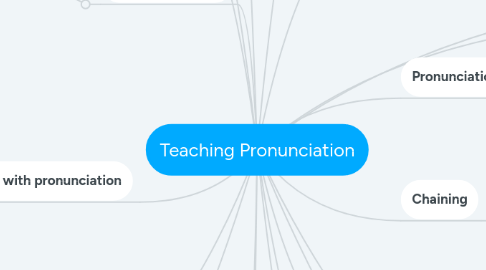
1. Poems
2. More fun with tongue-twisters and rhymes
3. Grammar
3.1. The most important think
3.2. The lexis is very important also
3.2.1. It is necessary to have the lexis suited to be understood
3.3. You can work that in relation with pronunciation
4. Problems with pronunciation
4.1. Revise the pronunciation
4.2. Work on the difficulties
4.3. Integrate new forms of pronunciation
5. Drilling
5.1. Ask to the students to repeat a word to work the pronunciation
5.2. The professor can give a model of sentence, words or structures
5.2.1. It is better to begin with a chorale with everybody who says the word together to put in confidence
5.2.2. Later we can ask to pronounce one by one to see the difficulties
5.3. The professor can help with drawings or mimes
5.3.1. The professors often have different accents best is to keep his accent but to know how it can say to itself with another accent
5.3.1.1. Need to teach receptive skills and productive skills
5.3.1.2. Read texts can be useful for the receptive skills
6. Open pair
6.1. A person asks questions and the other one answers
6.1.1. The professor can give instructions as letter to place in the question
7. Spelling activities
7.1. It is necessary to see the spelling after the pronunciation
7.1.1. Homographs
7.1.1.1. The same spelling but differents pronunciations
7.1.2. Homophone
7.1.2.1. Same pronunciation but different spelling
7.1.3. Make sentences, give a list of the words or look at the effect of certain letters after a vowel at the end of the word
7.1.3.1. Dictated
7.1.3.2. Reading exercise
7.1.3.3. Discrimination exercises
7.1.3.4. Listening
7.1.3.5. The professor has to choose what is useful
8. Listening activities
8.1. Understand natives speakers and see the pronunciations
8.1.1. Show a particular point or a difficulty
8.1.2. Show how to use a word or a conjugation in the context
8.1.3. To see how is used a pronunciation and to work on this pronunciation
9. Reading activities
9.1. Like listening it's a receptive activity
9.2. For bringing language features
9.3. Chose type of texts for integral pronunciation
9.3.1. Rhymes
9.3.2. Song lyrics
9.4. It's the link between spelling and pronunciation
9.5. You have to choose the right text
9.5.1. Encyclopeadia too much monotone
10. Too much enthusiasm can change the pronunciation
11. English became a very important means of communication
12. Contrast with native speaking or high level students
12.1. Show the difference of pronunciation
13. To revised and recycled
14. Pronunciation
14.1. Problem with an over accent
14.1.1. Look cold or uncurteous with german accent
14.2. Problem of understanding si badly pronounced
14.3. Necessity of having the good methods to work the figures of language
15. Necessity for the professor to plan a lexis and a structure
15.1. Plan the pronunciation at the same time
15.2. Anticipate the possible difficulties
15.3. Make a set lexis, grammar and pronunciation
16. Pronunciation model
16.1. Many models of pronunciation and the professor have to choose
16.2. The influence of received pronunciation persists
17. Chaining
17.1. To divide long or difficult sentences
17.1.1. Back chain where we begin with the end of the sentence
17.1.2. Front chain when we begin with the beginning of the sentence
17.1.3. It is necessary to add a part and to make repeat if there is an error
18. Drilling
18.1. Very important for the confidence and the work of the stress
18.2. To learn words and knowledges pronounced them
18.2.1. Possibility of making minimal pairs to work pronunciations and see again pronunciations already seen
18.2.2. If there are several languages in the class it is necessary to make pairs so that each can help the other one
18.3. The professor can give a list of words, words which are alike, words with close proximity or words with the same sound
18.3.1. It's better to take words which the person knows and to put them in their context
18.3.2. It's better to put of the vocabulary already known also
19. Taping students
19.1. Register first time then second time to show the difference
20. Releving
20.1. Raise words and pronunciations to use them afterward
20.1.1. Recycling of items
20.1.2. Notice language
